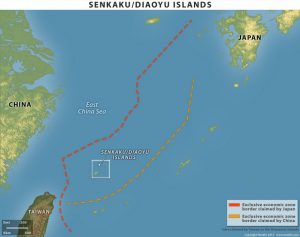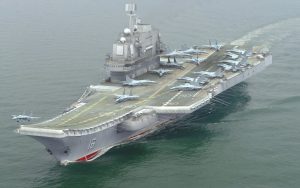Sino-Japanese Tensions Rising in the East China Sea
By Jason Blazevic / Jan 12, 2017 / Columnist at Utah Standard News
Chinese military operations in the East China Sea have greatly increased since 2012 causing much concern for Japan. Their concerns are seen through the recent passage of policy such as, the first ever National Security Strategy,1 the creation of the National Security Council and the increase of the military budget for the fifth straight year to $44 billion.2 The sea is of paramount concern for policy makers and military leaders of both states and they are looking out for shifts in the strategic balance caused by an increasingly powerful China and a decreasingly pacifistic Japan.
The escalating dispute is centered upon Exclusive Economic Zones (EEZ), which China extends to the Okinawan trough and Japan extends halfway between the Ryukyu islands and the Chinese mainland. The EEZ dispute is magnified by energy resources, sea lanes vital for trade and energy, and the strategic Senkaku/Diaoyu islands neighboring Taiwan at the southern end of the sea. Both China and Japan import the majority of their oil from the Middle-East and Africa via the sea lanes of the contested sea. China and Japan’s reliance upon imported oil has intensified fear of threats to nearby sea lanes and territorial and resource claims.3
China has increasingly sought to harass Japanese surveillance and security operations in disputed areas of the East China Sea by countering Japanese planes and naval vessels as well as through an increased defense budget passing $150 billion and policies such as the 2013 East China Sea Air Defense Identification Zone.4 These actions are aided by an increasingly powerful blue water-capable navy with Houbei patrol vessels, Type 056 corvettes, Type 052 guided missile destroyers, Type 093 Shang class submarines and the refurbished aircraft carrier Liaoning.5
Japanese authorities believe that China is pushing the envelope to justify its saber rattling while simultaneously challenging and shifting the balance of power.6 Japanese Prime Minister Shizo Abe has sought to maintain the status quo of the region by changing Japan’s place in it. Abe has engaged a strategy known as proactive pacifism7 seen through such measures as increased defense spending, independent defense policy, the construction of a radar base on Yonaguni island, and the construction of helicarriers.8 The strategy has also furthered Japanese-American military cooperation through the allowance of collective selfdefense implied in the government’s pledge to militarily support US forces in defense of Taiwan.
9
Policymakers and military leaders in China believe that control of the continental shelf and the Senkaku/Diaoyu islands, as well as, reunification with Taiwan, is essential for defense of the sea lanes and energy resources from an increasingly powerful Japan and its ally, the US.10 As such, President Xi Jinping has called for a more modern navy to protect resource
development and distant sea lanes as a matter of national security.
Military growth, decreasing pacifism, and status quo challenges could greatly magnify tension in the East China Sea in 2017. Such related actions taken by either government may cause more reactive and dangerous policies and strategies built on suspicion, competition and war. A zero sum contest could be the result, which would be devastating for the region and the world.
 1 Kotani, Tetsuo (2014), U.S.-Japan Allied Maritime Strategy: Balancing the Rise of Maritime China, Washington D.C.: Center for Strategic and International Studies. file:///C:/Users/Jason/Downloads/140422_Kotani_USJapanAlliance_6.pdf
1 Kotani, Tetsuo (2014), U.S.-Japan Allied Maritime Strategy: Balancing the Rise of Maritime China, Washington D.C.: Center for Strategic and International Studies. file:///C:/Users/Jason/Downloads/140422_Kotani_USJapanAlliance_6.pdf
2 Robbie Gramer. “With Historic Defense Spending Boost, Japan Turns Further Away from Pacifism.” Foreign Policy. September 22, 2016. http://foreignpolicy.com/2016/12/22/with-historic-defense-spending-boost-japan-turns-further-away-from-pacifism-tensions-south-china-sea-senkaku-islands-dispute/?utm_content=buffer114a7&utm_medium=social&utm_source=facebook.com&utm_campaign=buffer
3 Forsyth, Ian (2015), A Tale of Two Conflicts: The East and South China Seas Disputes and the Risk of War, Singapore: S. Rajaratnam School of International Studies.
https://www.rsis.edu.sg/wp-content/uploads/2015/02/PR150206_A_Tale_of_Two_Conflicts.pdf
4 Sutirtho Patranobis. “China’s Defense Budget to Cross $150 bn, Four Times that of India.” Hindustan Times.
March 4, 2016. http://www.hindustantimes.com/world/china-s-defence-budget-to-cross-150-bn-four-times-thatof-
india-s/story-aXsY82e4zBSpGVN4y01fqM.html
5 “MSDF spots China’s first aircraft carrier sailing into the Pacific.” Japan Times. December 25, 2016.
http://nationalinterest.org/blog/the-buzz/why-the-us-navy-could-be-big-trouble-china-plans-351-ships-16101
6 Yuki Tatsumi. “China: Pushing the Envelope in the East China Sea?” The Diplomat. June 10, 2016.
7 Michael Hoffman. “Where Will Proactive Pacifism Lead Us?” Japan Times. March 7, 2015.
http://www.japantimes.co.jp/news/2015/03/07/national/media-national/will-proactive-pacifism-leadus/#.
WGGH0lMrKpo
8 Akhilesh Pillalamarri. “Japan’s Navy Unveils Aircraft Carrier in Disguise.” The National Interest. March 25, 2015.
http://nationalinterest.org/blog/the-buzz/japans-navy-unveils-aircraft-carrier-disguise-12483
9 Chanlett-Avery, Emma, Mark E, Manyin, Ian E. Rinehart, Rebecca M. Nelson and Brock T. Williams (2015), Japan-
U.S. Relations: Issues for Congress, Washington D.C: Congressional Research Service.
https://fas.org/sgp/crs/row/RL33436.pdf
10 O’Rourke, Ronald (2016), China Naval Modernization: Implications for U.S. Navy Capabilities – Background and
Issues for Congress, Washington D.C.: Congressional Research Service, Library of Congress.
https://fas.org/sgp/crs/row/RL33153.pdf
Steal our Stuff!
Utah Standard News is deeply committed to restoring government oversight through non-partisan journalism. In order to provide top-quality news coverage and investigative work to your readers, our work is free for print by clicking on the ‘Republish/Reprint‘ button at the top right of this article.
Media Requests or Partnership Inquiries
We have a growing nationwide network. If you’re interested in learning more about our work or receiving regular content from our reporters please contact our Director of Communication and Media Outreach at ed@utahstandardnews.com.
Disclaimer:
The author of each article published on this web site owns his or her own words. The opinions, beliefs and viewpoints expressed by the various authors and forum participants on this site do not necessarily reflect the opinions, beliefs and viewpoints of Utah Standard News or official policies of the USN and may actually reflect positions that USN actively opposes.
The articles from our ‘Friends’ are under copyright and are published with permission. Any republishing of these articles is STRICTLY PROHIBITED without written consent from the original Publisher.
Utah Standard News depends on the support of readers like you.
Good Journalism requires time, expertise, passion and money. We know you appreciate the coverage here. Please help us to continue as an alternative news website by becoming a subscriber or making a donation. To learn more about our subscription options or make a donation, click here.
To Advertise on UtahStandardNews.com, please contact us at: ed@utahstandardnews.com.



Comments - No Responses to “Sino-Japanese Tensions Rising in the East China Sea”
Sure is empty down here...